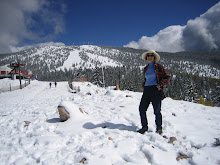TOUR EL CAMINO REAL-DAY ONE

Thursday, March 1
El Paso, Texas - 8 a.m. Inez and I meet our fellow travelers for the first time. We board a bus, cross the border at Ciudad Juarez, and depart for Chihuahua, Mexico. It’s there where we’ll spend the first night of our two-week tour. The process takes a long time, and we have to change busses several times before climbing into another bus, the vehicle that will carry us all the way to Zacatecas.
El Camino Real! The route serves as a kind of time machine. It was used for centuries by Native Americans; then came the Spanish; today, the Anglo and Hispanic seekers of history. There’s a reason our destination is Zacatecas, for the Camino Real story begins with that city. Dr. Jackson puts it this way: “The first toehold of the Spanish in La Gran Chichimeca, the large area that lay north of the region settled by sedentary agricultural Indians, since the silver strike provided the impetus for all settlement in northern Mexico...How many volunteers would Juan de Onate have been able to enlist for his expedition to the north in 1598 without the hope of another Zacatecas?” (Following the Royal Road, University of New Mexico Press, 2006).
Fitting the description by Marc Simmons in the introduction to Jackson’s Following the Royal Road, we on the tour embarked as “modern-day explorers wishing to follow in the footsteps of conquistadors, Franciscan padres, soldiers, royal officials, pioneering Hispanic families, miners, and finally merchantmen -- Spanish, Mexican, and American.” We were following a long tradition.
Speaking of merchants, on the other side of the border, the Mexican side, I observe that many of Chihuahua’s businesses are the same that we find in my hometown of Santa Fe, New Mexico -- Office Depot, Domino’s Pizza, WalMart.
As we ride south toward sprawling Ciudad Juarez, our native guide, Luis began what would be an ongoing cultural overview. The Sacred Mother, Virgin of Guadalupe, he explained, was and is still revered throughout Mexico. “The vision of Guadalupe,” he said, “was depicted on the flag of Hidalgo when Mexico got its independence from Spain.”
Noontime traffic makes progress dismally slow. “Juarez is a terrible place,” commented Luis. “It’s a place where people are just passing through. The mestizo culture comprises a world within a world. It’s always been this way. Indians -- Tewa, Tiwa, and Acoma; Europeans, Bohemians from everywhere.” He waves his arms expansively toward the windows on either side of the bus. We stop at San Lorenzo and Senecu communities and take time to briefly tour Guadalupe Mission, the first of dozens of churches that will highlight our journey.
An hour or so south of Juarez, we reach the Samalayuca Desert, then disembark and climb a sand dune -- one of many -- near the road. It is windy and surprisingly cold. Our leader, Hal, reminds us that this is where the covered wagons had to take a detour. The dunes stretch away toward the horizon. I’m reminded of the White Sands area in southern New Mexico.
Maestro Luis stands up in the front of the bus, microphone in hand. It is time once again for his continuing “on the road” lecture on Mexico’s culture and history. “For Indians,” he explains, there was not a conception of owning land. They didn’t believe in naming land after their names. When Europeans came, so did territoriality and the concept of owning property. Concerns about having enough water took on more importance. Land ownership questions and water rights engendered violence. Another divisive issue was salt, a valuable commodity in early times. From that, the salt war resulted.”
Lunch will be late today, as we have many miles to cover before reaching tonight’s destination, Chihuahua. We passed an out-of-commission water park near Ojo Lucero, a contraption along the lines of Uncle Cliff’s in Albuquerque. Luis informs us that during the summer a water pump activates the park and villagers come here to cool off.
Half an hour later, at the Arizona Restaurant, we enjoy burritos and lemonade. We visit the presidio site of El Carrizel, location of a rare Mexican victory over the United States. The bus rumbles south into evening and we enjoy a gorgeous sunset before finally arriving at Chihuahua and checking into the Tierra Blanca Hotel.







0 Comments:
Post a Comment
<< Home